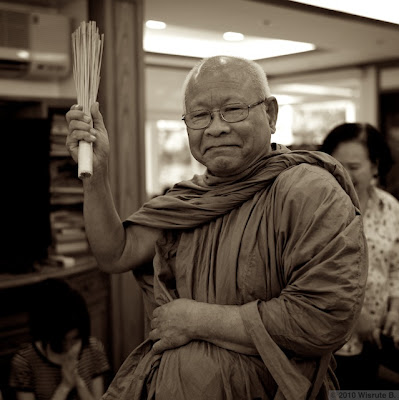This has been a rather intense week for me and, I'm sure, for many Thai citizens alike. The two-month long demonstration came to an end on Wednesday but it is far from over. I will not enter into too much details here, but only to set a few things straight, with a promise to share a few photographs relating to this subject.
The two-month long demonstration rooted back further than the military coup in 2006. Most international media, sadly, are only citing the coup as the cause along with wealth gaps which exists here and so are in many developing countries around the world. The wealth gap did not just started. It has been there for decades. Some would say double standard treatment of the government is another cause. That, too, is nothing new. Double standard treatments have long been part of Thailand, no matter which administration or government. (At one point Thai Airways, co-owned by the government, had separate check-in counters for government officials.) What many had completely failed to notice was that the coup itself was far less violent than what had happened here in Bangkok on May 19, 2010.
I am not a supporter of the airport closure, led by the Yellow Shirt group either. I firmly believe that both sides love their country, however, one evil man and his servants had taken advantage of the Red Shirts for their own benefits. Evidence can be seen through various videos that their leaders had given orders to burn down the city of Bangkok. International media sees riots as a reaction to the crack-down, most Thais see them as planned terrorism.
In the last two months, the government had given all possible opportunities to negotiate and to peacefully end the protest. These offers include three (televised) negotiations (which failed as the Red Shirt leaders refused to compromise beyond immediate parliament dissolution), at least two separate offers for re-election dates (where the soonest offer is dated for November 14, 2010), and the Road Map proposal to reform the country where the working class would be more fairly represented. These opportunities somehow escaped the attention of foreign media, perhaps with exception of Al Ja Zeera network. The Road Map was partially accepted by the Red Leaders who, at the final stages, made their final demands requesting guaranteed bails, safety, and complete dismissal of all charges against them. How these demands are related to democracy is difficult to see. What the international news agencies had failed to highlight was the Chulalongkorn Hospital raid by the Red Shirts. They not only blocked the streets, entrances, and exits, but at one point hundreds of protesters raided the hospital. Hundreds of patients had to be relocated to other hospitals around the city, not to mention the frightened nurses and hospital staff. Such inhumane behavior is cruel and unacceptable, a polar opposite of their claims to have a peaceful demonstration.
On Wednesday, May 19, the government announced it would secure parameters and close in on the demonstrators in order to reclaim the streets back. Bombs and grenades were found along the tire barriers. Soldiers were killed, and unfortunately so were some journalists. As the troops closed in, three of the Red Shirt leaders announced their surrenders, immediately claiming it would be for the safety of their (red shirt) people. At this point, they, themselves, disappointed many protesters who later became extremely upset. That afternoon, reports started coming in that many banks, shops, ATMs, and shopping complexes were looted, destroyed, and set on fire. Channel 3 (local TV network)'s building was set on fire by armed protesters while the TV staff were working upstairs, trapping them in the building. Fortunately, a helicopter rescue effort saved many, as fire was extinguished after the protesters had moved on. Central World, a leading shopping complex, was set alight soon after the surrender announcement. Snipers and shooters were busy keeping the rescue and fire prevention efforts at bay. Fire burnt for nine hours before any fire engines could access the area. Finally part of the Central World building collapsed and the fire-fighters were able to control the flame later in the night.
This act of vandalism and terrorism are not impulse reaction, but rather an orchestrated one. It is easily seen that structures whose property owners are related in some way to the former-PM's family have been left more or less undamaged. Channel 3, for example, was heavily targeted likely due to the recent airing of the local celebrity's "I love my Father" (King, in this case) speech. Convenient stores have been looted, phone booths and ATMs have been damaged. News report showing footage of some protesters' bags, going through security checks by the military volunteers, with looted goods inside. So much for democracy they're asking for. Footage of Red Shirt Leaders encouraging their followers to burn down the city can be seen on YouTube. They (yes, more than one) explicitly stated that if things fail, just burn the city down.
Many thoughts went through my head that Wednesday night. Having read many things about the Red Shirt movement, I knew before hand that this demonstration would not end well. It exceeded my expectation, and by that, I meant, it's worse than I had expected. And this is just the first of many more chapters....
Below are some of the images I had taken around the main protest site (from the old Panasonic LX3) during holiday period in 2008. The most obvious change is the collapse of Zen Department Store, part of the Central World Building. It will be missed by many. For the most part, it will be remembered for what had taken place here on May 19, 2010.
[Note: Most of the images here were taken at the useful f2.0. Some shots were handheld while others were shot with the camera braced on the handrails for stability. These are JPGs straight from the camera! I became a believer in the LX3 and DLux 4 after that night.]























